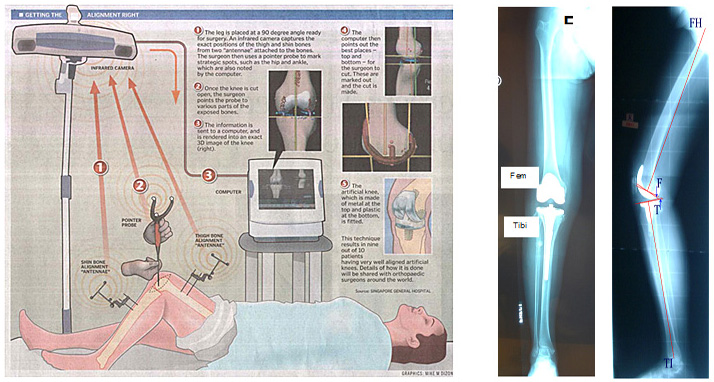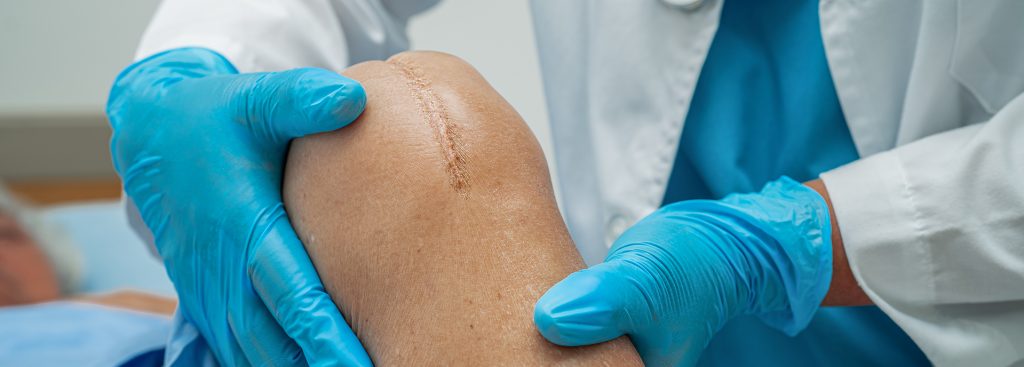Meniscus tear is a very common knee injury. The meniscus is a rubbery, C-shaped disc found in your knee that behaves like a cushion between your shinbone and your thighbone. There are two menisci in each knee to keep your knee steady by balancing your weight across the knee.
A meniscus tear is usually caused by sudden and forced twisting or turning of the knee when it is bent. People who often play sports or lift heavy objects are at higher risk of meniscus tear.
The RICE treatment (Rest, Ice, Compress, Elevate) and ample rest is sometimes enough to relieve the pain and give the meniscus tear to heal on its own. Some cases may however require surgical treatment like the knee arthroscopy.

Conventional knee joint replacement technique uses alignment rods to guide surgeon in the bone cuts. However, the outcome heavily depends on the surgeon's experience and patient's conditions like density of soft bones (osteoporosis) - leading to a less than ideal outcome. In computer-assisted and robotic surgery, the computer is like a GPS allowing the surgeon to be able to rehearse and adjust for the best outcome.
Currently, there are only two dedicated orthopaedic robotic systems for the replacement surgery.
This is a haptic robotic arm where the surgeon guides the arm during the surgery. The current software only allow for acetabular milling for hip replacement surgery and partial/unicondylar knee replacement surgery. The total knee replacement platform will be starting beta testing soon.
The Robodoc system is not a novel technique. More than 30,000 total knee replacement surgeries have been performed successfully. Dr Chin Pak Lin started the robotic knee program on 16 May 2012. To date, about 60 such surgeries have been successfully performed, audited and followed-up. This robotic arm is an active robot where the surgeon merely coaches the arm while it performs all the work. It is very different from the MAKOplasty platform as this is is an open platform where both unicondylar and total knee replacement surgeries can be performed.
In general, most orthopaedic specialist can handle a straight forward joint replacement surgery. A complex joint replacement include cases where there is severe deformities, very limited motion or the primary surgery has gone wrong (due to aseptic loosening, poor alignmet or infection).
As modern medicine improves the lifespan for males and females, patients with previous surgeries and implants who need a joint replacement surgery become very challenging as conventional techniques cannot be used.
Dr Chin Pak Lin had been the key person in handling complex and revision joint replacement surgeries formerly at SGH.
Knee arthroscopy is a minimally invasive procedure where a camera and working portal/s are placed through tiny incisions to visualize the knee. Multiple types of therapeutic procedures can be carried out:
The Anterior Cruciate Ligament (ACL) is a major stabilizing ligament of the knee. ACL injury is one of the commonest knee injury and ACL reconstruction is one of the commonest surgery done. The ACL reconstruction can be done using keyhole technique. Newer advances involve using special techniques to:

Throughout total knee replacement surgery, an artificial prosthesis is surgically implanted to take over the function of the disease knee joint. Indications of knee joint replacement surgery are severe pain with loss of function. Very effective surgery with a reported 90% satisfaction rate lasting about 20 years.
Novel advances:Newer techniques include using PRP (Platelet-Rich Plasma) combined with the aforementioned injections.